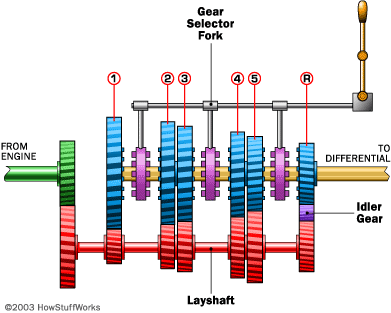- also known as a manual gearbox or standard transmission (informally, a "manual", "straight shift", "stick (shift)" (US), or "straight drive")
- Manual transmissions are characterized by gear ratios that are selectable by locking selected gear pairs to the output shaft inside the transmission
-Contemporary automobile manual transmissions typically use four to six forward gears and one reverse gear, although automobile manual transmissions have been built with as few as two and as many as eight gears.
-Transmission for heavy trucks and other heavy equipment usually have at least 9 gears so the transmission can offer both a wide range of gears and close gear ratios to keep the engine running in the power band.
-Some heavy vehicle transmissions have dozens of gears, but many are duplicates, introduced as an accident of combining gear sets, or introduced to simplify shifting.
-To shift to a higher gear, the transmission is put in neutral and the engine allowed to slow down until the transmission parts for the next gear are at a proper speed to engage.
-To shift to a higher gear, the transmission is put in neutral and the engine allowed to slow down until the transmission parts for the next gear are at a proper speed to engage.
-To shift to a lower gear, the transmission is put in neutral and the throttle is used to speed up the engine and thus the relevant transmission parts, to match speeds for engaging the next lower gear.
- For both upshifts and downshifts, the clutch is released (engaged) while in neutral. Some drivers use the clutch only for starting from a stop, and shifts are done without the clutch.
-Other drivers will depress (disengage) the clutch, shift to neutral, then engage the clutch momentarily to force transmission parts to match the engine speed, then depress the clutch again to shift to the next gear, a process called double clutching.

No comments:
Post a Comment